From clicks to customers - B2B lead generation
B2B Lead Generation for Software Companies Doesn't Work Anymore ☠️ Are you wasting your resources on agencies, paid advertising or ephemeral email campaigns? Your marketing strategy doesn't take into account long sales cycles or you wonder why your leads aren't buying?
In this video and blog post, you'll learn from B2B marketing experts Björn Sjut, Joël L. Capt, Kevin Sturm and Marc Gasser the latest growth hacks for automating nurturing of new and existing contacts to identify ready-to-buy leads.
B2B lead generation is a complex topic. When looking for answers for your business, every agency or consultant claims to have the solution. All have exactly your hammer - usually also regardless of what problems or even nails offer themselves.
That's why it is but just exciting that we have an expert panel of different entrepreneurs. They also brought their hammer. Oh no, they bring rather a whole toolbox to fix the most diverse nails and screws. Let's see with which fastening technology today theleads are best merged, glued, welded or nailed with companies.
Introduction
Introduction of the experts
Joël L. CapT Founder Realgrowthhacking
You can't avoid him in Switzerland, is felt at every Series A startup with his service.
Tagline: Joël has built a proven system to grow startups.
In his toolbox is an enablement program that helps you build an acquisition engine.He learned it all in Silicon Valley and at one of Switzerland's fastest-growing startups.
LinkedIn #scaling, #startups, #growthhacking
Kevin Sturm Founder Growthbay
Kevin is how I've come to know him, he doesn't think much of guessing games but is quick to hypothesize and test.
Tagline: Move away from short-term hacks and silver-bullet thinking to sustainable, data-driven growth engines with repeatable results.
Toolbox: Inbound Engine → Demand CaptureHe learned this at consulting firms and his previous health insurance startup as Head of Marketing and Product Development
LinkedIn #dataanalytics, #performancemarketing
Björn Sjut Founder Finc3 / Bizmut Marketing
Björn's workshops are really cool. The channel mix is brought to the point and the content so clear that you wonder why you did not come up with it yourself.
Tagline: Marketing as a measurable investment, not a cost block. B2B marketing must de-anonymize relevant interest in a scalable way. His toolbox: building the optimal channel mix of media and direct outreach.
He learned as with his ancient (2012, that's ancient in online marketing, right?) online marketing group Finc3, based in Hamburg
LinkedIn #crm, #analytics, #b2bmarketing, #growthhacking, #performancemarketing
Valentin Binnendijk and I, Marc Gasser
We are publishers of the Marketing Automation Report and founders of Pedalix.
Tagline: We automate lead nurturing for B2B companies, identifying contacts who are ready to buy.Our toolbox: we install a machine at companies that qualifies leads automatically.
Valentin: #B2BSaaS #Productmanagement
Marc: #MarketingAutomation #Productmarketing #B2BMarketing
Explanation of terms based on customer journey
I always try to make sure that we think along the Customer Journey and would like to classify the topic of lead generation here
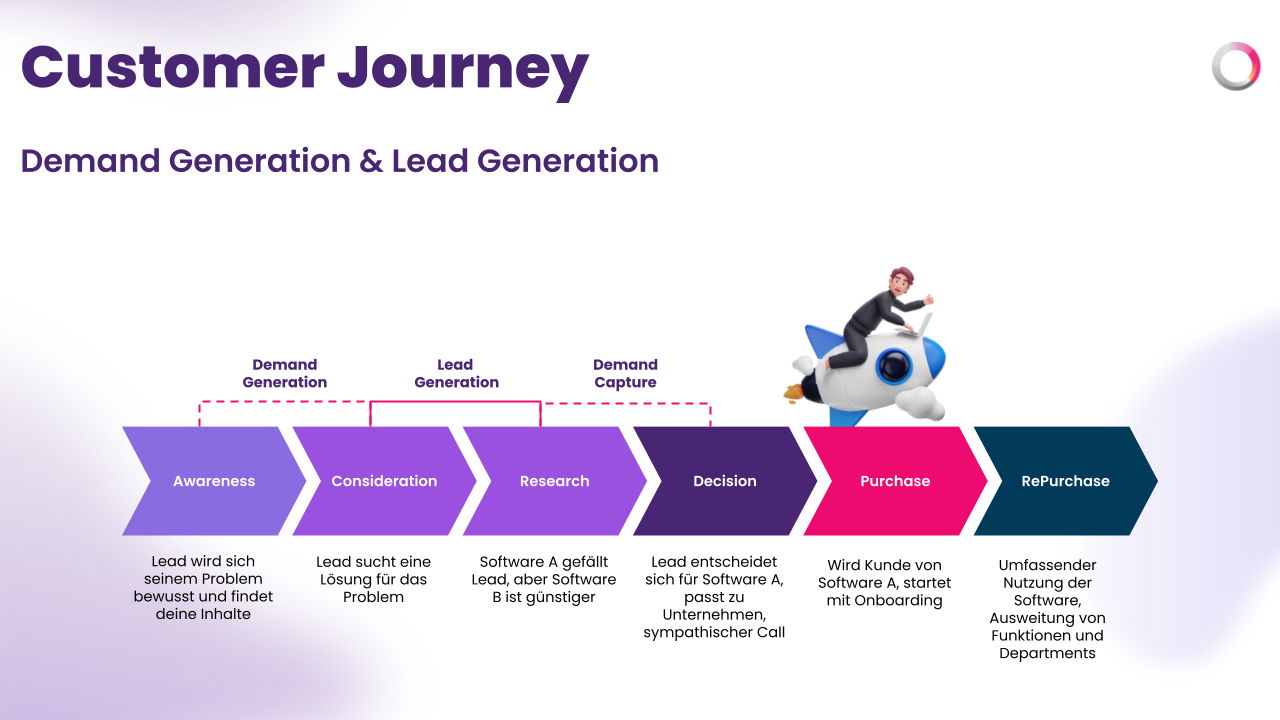
It's extremely common to forget that lead generation doesn't start from the very beginning, but there's an element called demand generation in front of it. So we define the lead generation process from the moment a lead can convert and becomes contactable, that is, we know its email address afterwards, the lead de-anonymizes. Before that, it is about raising awareness, if someone with a problem finds your content, that is by definition only Demand Generation. The “only”, is not meant to be disrespectful at all, on the contrary, it is Demand Generation and then leads to the next step, which is Lead Generation. It is not the whole customer journey meant, but the range of a lead from conversion to the point that this can then ultimately buy.
Problems with B2B lead generation
We have made various surveys in the target group B2B marketers. A comprehensive study with the ZHAW University of Applied Sciences, webinar participants and in micro-surveys. We received the following responses to the question: “When we look at the customer journey, where do you see the biggest problems in B2B companies, what is repeatedly done wrong and in which phase?”.
Marketing Automation Report 2023
In the Marketing Automation Report, over 400 companies from the DACH region have participated each year.
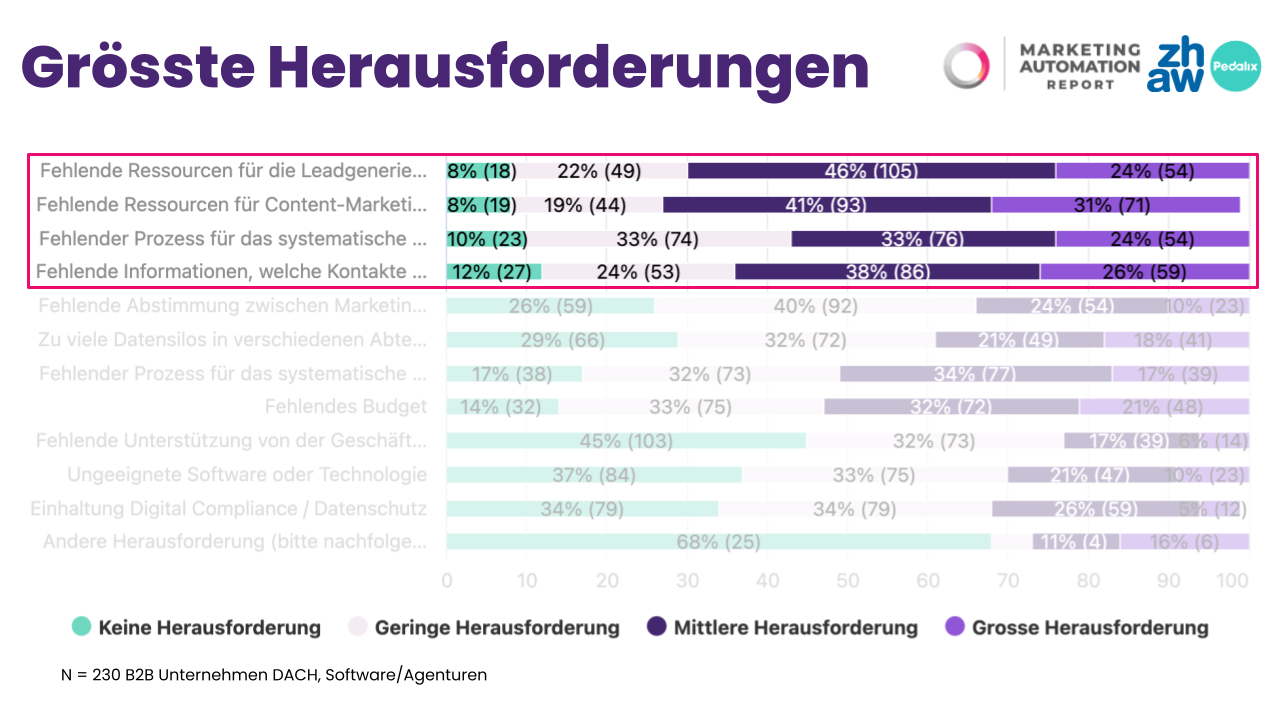
When we filter by B2B and software companies, we get the following top challenges:
- Missing resources for lead generation
- Missing resources for content marketing
- Missing process for systematically nurturing leads
- Missing information on which contacts are ready to buy
Webinar Participants
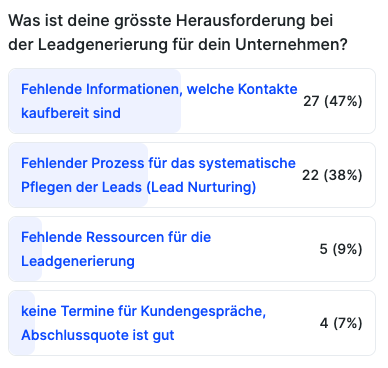
Similar responses also emerged from surveys in our B2B lead generation webinars on the same question:
- Missing information on which contacts are ready to buy
- Missing process for systematically nurturing leads
What do the experts say about B2B marketers' biggest challenges?
When we look at this Customer Journey, where do you see Björn first out, where do you see Björn, the biggest problems with B2B companies? What is repeatedly done wrong and why?
Björn
On the one hand, of course, the challenge in B2B is that customer journeys are very long and involve multiple people. That means it's often difficult to estimate the marketing decisions you have to make today (i.e. in which channels do I invest how much money, in which tactics do I invest how much money) in such a way that they will then have an impact when the customer journey takes six, nine, twelve months. And that's why, from our point of view, it's always very important to measure not only Sales Qualified Leads (SQLs) or Marketing Qualified Leads (MQLs), but also the pipeline impact, the probability of closing deals, and revenue. It takes revenue attribution. You can't wait until the deal is through, then, you have to calculate with the closing probabilities. Then close to the media cost point today already make the marketing decisions.
So, a clean setup of cohort analysis is quite important. That is, from my point of view, still a big challenge for many companies, to merge this CRM data with marketing data.
And the second point is to accompany the Journeys well. Because the journeys are so long and because people go through different stages, you can't rely on sales to solve everything, as many companies still do. You have to accompany this journey with good account-based marketing (ABM), which provides companies that are in a certain phase with targeted, conclusion-oriented messages, with knowledge, with knowledge, with education.
Kevin, can you maybe point out the most common problems as well? Leaning on the Customer Journey, what is being done wrong?
Kevin
The biggest problem I keep running into is that I'm dealing with data spaghetti. That means that the data, whether it's in CRM or Google Analytics or an ad account, is just not maintained cleanly, that the attribution doesn't really work. A vivid example is always, what is the main conversion? So, what is it that matters? What metric is really important to the business? What is the goal to achieve? Often that's not even set up correctly. Then, of course, a basic setup, right? So, what does the website look like? What does the funnel look like in a very basic way? Where do people bounce? So, what's the bottleneck? A clean foundation is really something that's always missing – there's an extreme amount of potential there. That's one side. The other side is that I encounter an extremely high level of impatience and activism, that companies see a lot of things as equally important and don't really define focus topics. They also switch back and forth between channels, strategies and tactics. Then there are no clear OKRs. There are no defined goals that can be broken down to individual employees in sales or marketing, for example.
This mindset is not really the same.
This mindset of just doing it and seeing how much spaghetti stick to the wall – I don't see that as goal-oriented and leads to spending a lot of money on channels that don't really work, that don't show any traction. This then goes in the direction of premature scaling, to use a term from the startup world. You don't want to do that with a product, you don't want to do that with a channel, and you don't want to do that with a landing page. I think it's quite important to build something that plays together cleanly and works harmoniously.
Cool. And Joel, what do you think about this? Where do you see the problems?
Joël
I can only support Kevin's point here regarding tracking. We see with most startups we work with that there is no data foundation, so they can't track the channels end-to-end at all. Accordingly, they are not aware of the problems along the customer journey. An acute problem, but what we often do here is give the advice that you first have to take a big step back. When a startup begins, then of course you just use everything you have - the personal network, to get the first leads, to get the first customers. But then if you really want to grow or even scale, then you have to think about what is actually the right go-to-market (GTM) strategy for my company. So depending on the deal size that I'm selling, what are the right channels? So if we're selling small deal sizes, I'd like to have more of an inbound motion, with no-touch or low-touch or no sales team at all.
And if I'm Midsized, then a sales team is part of that, accordingly other channels. Or if I'm Enterprise then even, then I'm in Account-Based Marketing (ABM), Account-Based Sales (ABS). That changes the whole game again. The channels should then not just be looked at as lead gen, but as actual functions of the customer journey and serve as touchpoints and nurturing to get the prospects to buy.
That means if we try to ramp it up too early, spaghetti will fly around our heads. It takes a foundation. Customer journeys are so long and complex, you need a data foundation - a data foundation. And what I find exciting from your side, Joël, is the deal size. That then implies completely different tactics that it entails.
What are marketers' goals in 2023?
Talking about problems, well, that's easy. Let's take a closer look, where exactly do these problems occur and what is the objective behind them? What is even on the priority list with marketers where problems occur.
Marketing Automation Report 2023
In the Marketing Automation Report, the question, about the most important goals in the next 12 months is evident right at the beginning of the market survey.
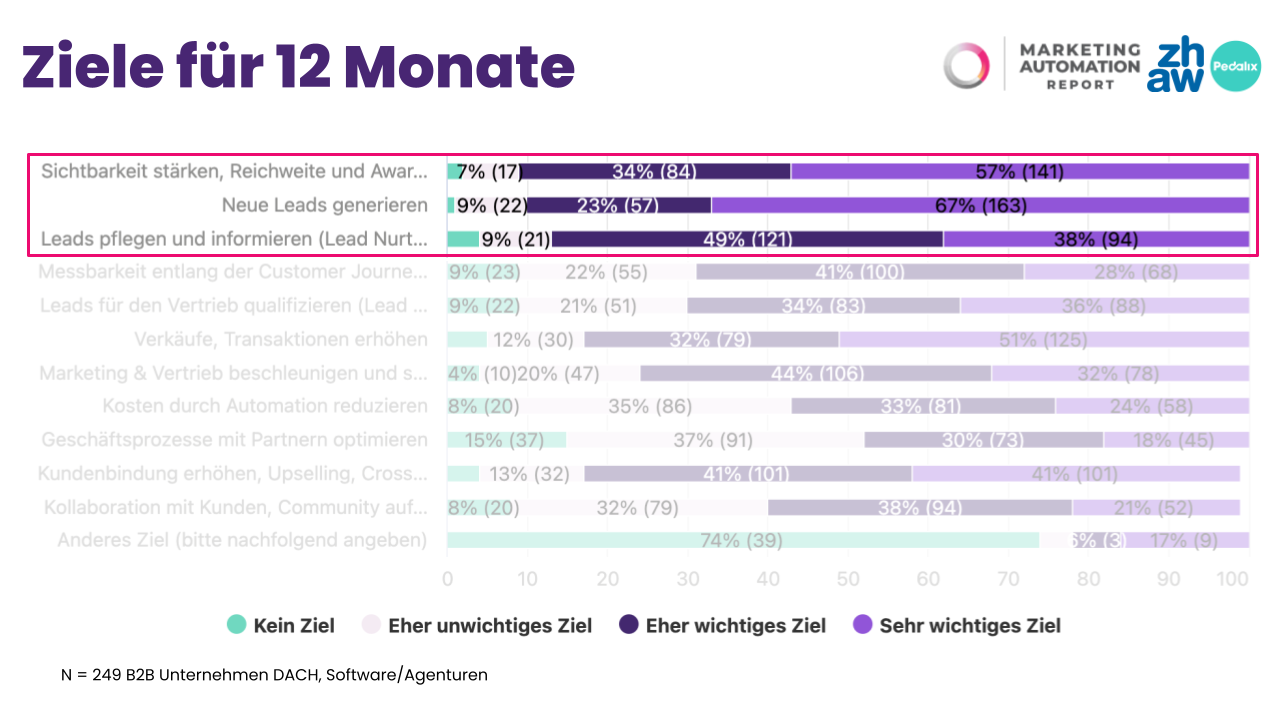
Filtered by B2B and software companies, 249 responses show the following picture. I have the following very important or somewhat important goal:
- Strengthen visibility, increase reach and awareness
- Generate new leads
- Maintain and inform leads (lead nurturing)
Webinar Participants
Now let's ask all the participants in the webinar “B2B Lead Generation”, which marketing goals are relevant in the next 12 months?
This resulted in the following list of priorities:
- I need good leads, just good leads!
- Higher quality contact information and purchase readiness information
- Building relevance, opinion leadership and product positioning
- Improving customer care and retention
- Marketing and sales channels are working but not yet scaling
- The sales pipeline has dried up and now needs more meetings
You can see there is obviously more focus on leads in the B2B Lead Generation webinar
Solutions, what else works?
Let's move on to the solutions. Now it becomes a bit difficult. How can we fix these problems now? Because quickly build a foundation, that is also not without. Let's ask our experts:
Joël, can I trigger you again right now? What tactics do you see that still work in B2B? Can you explain your approach that still gets results today?
Joël
Yes sure. I can't make general statements regarding B2B, of course, but let's say you have a deal size of over EUR/CHF 10,000. That actually qualifies me for a go-to-market strategy, where I can also build a sales team behind it. And then, of course, various challenges come into question. Now it also depends a little bit on the stage of the company. If I'm in an early stage now, then I want to invest in something that can give me a lot of impact quickly. A lot of startups then do outbound emailing, so going directly to people to be able to book meetings there. It's a very direct channel. I don't have to invest heavily in marketing until I get results. Problems we see there are that people don't really do it technology-assisted. It's too manual and if I'm paying a European wage for a person to manually gather contacts, it's not really efficient. That's where we're talking about automated outbound engines that you have to build and then you can identify and scrap Ideal Customer Profiles (ICP) from the Internet in a very targeted way. You can then enrich these contacts so that you can reach them at scale.
Not mass emails, but very targeted to the right ICPs, to the right buyer personas, so that you can then achieve the desired effects.
Kevin, what are your tactics? What do you see that still works?
Kevin
I usually take a few steps back right away and do a clean analysis first. I try to understand what the basic setup is. What's working, what's not working? Most of the time you can see that pretty well if you map the funnel and the pipeline and then segment the whole thing to the individual channels. So for example paid ads, say Google Ads or LinkedIn, but also organic traffic. So that you can see through the entire funnel. How much are we spending? What are we investing and what are we getting back? Then what are the corresponding customer acquisition costs (CAC) and key metrics? And finally, how many leads or deals specifically are we actually bringing in through a particular channel? These are questions that we fill in together with the companies, we call the master KPI sheet. That's where we run into problems because, as I also mentioned earlier, this end-to-end tracking (it goes back into the attribution issue) doesn't work. Or for example analytics tools that are not connected to CRMs. And that's where it becomes extremely difficult to then link. So that's mostly the basic approach. What we do then is a main KPI, a hard KPI, like revenue or number of deals closed - so not fluff like MQLs or something - is defined. Then it's tracked continuously. There is baselining and then it is tracked continuously over weeks, months, quarters so that you can see how it develops accordingly. Based on the analysis, you have to prioritize and derive measures. My approach is always “follow the money”. Not everything is equally important. That can have a big effect in the short term and increase sales. Then we try to go in there and expand. Perhaps a final comment on this basic approach. It is very important to reduce complexity. Not to go and build X number of different funnels, but to say to yourself, based on the research, “we'll take a country, we'll take a segment, we'll take maybe an ICP or a target group, a channel, a landing page and a conversion mechanism, in other words, a trigger, and then try to determine in the first place how that works, based on the data that we currently have.”
That would be a first version. You work with that and then you build that out. Then you can consider - like if people are bouncing 90% of the time on the landing page - what do we need to do? Maybe we could use retargeting to solve that problem, with LinkedIn. So you can test it and see what happens. This mindset that you experiment, that you're also willing to make mistakes and not bring in too much complexity, that's extremely important. And that has always proven itself in practice with us now.
Björn, can I still ask you to share your view, what are your experiences, what still works today?
Björn
I would say two very pragmatic things. One is that you have to drag along the context where the users come from. That means I need to understand as early as possible in the customer journey whether the customer can buy at all. So the main question point here is “Is there a lack of information about which contacts are ready to buy?”. There are actually predictive questions you can ask in any business model. If I'm a home builder, for example, the predictive question I can ask today when someone downloads a model home catalog is, “do they actually have a property?” That yes/no question determines whether I can even monetize that customer or that lead in the next six months. There is such a simple yes/no question for every business model, which does not depress the conversion, but provides information about whether a customer even belongs to the relevant spectrum of possible buyers, whether he could theoretically buy. You have to pull these questions right to the front in the sales process. Everyone can do that here this afternoon as an exercise, what is the predictive yes/no question I can ask. That question determines whether a customer even belongs in the relevant set. Not how many employees do they have or what is their projected budget, but just condense it down to the yes/no question.
The second thing, which then works in terms of channel mix and tactics mix, depends very much on the product, precisely. Andrus Purde, the former CMO of Pipedrive had developed quite a good matrix. On the one hand, there's Category Urgency and on the other hand, Category Awareness. And if I have a product where people know it exists and there is a high Abschcluss Urgency, then you have to maximize findability in the channel mix. That's the main focus then: maximize findability. If, on the other hand, I have a product that hardly anyone in my target audience knows about and there is little urgency, then I have to maximize interruptions and make sure that I don't fall into demand capture, i.e. that I don't collect the demand, but rather build up the demand first through education and inspiration. That's why there is no one mix that works for everything, but this matrix, Category Urgency, Category Awareness shows where I stand with my product. That's certainly quite smart to find a basis for what a channel mix should look like. With more complex products, it's often the case that you can also make such a matrix quite simply according to individual features. Often people know the basic product and have a high category awareness, but not for certain features. And you have to build demand first. A typical SaaS example is screen recording - many people know the tool, but a new feature such as automatic transcription and integration into an internal company search - that would not be Maximize Findability, because no one knows that it exists, but Maximize Interruptions. That's where I need to build demand in the target audience first.
Cool point. I think , this is where we start right away with a next poll. Which of these channels do you actually use? Anyway, I think what you say is exciting. So I've now taken away from Kevin, it's about micro-journeys as a foundation and testing these experiments first. Joël is talking about the ICP in the extreme, defining it precisely and relevant messaging. And what Björn puts on top of that is identifying purchase readiness. I'll reference our podcast right now - where we say there's only 1 to 3 percent in that mode "ready to buy" and you can ask that question to find out if that's ready to buy or not. Then I understand the Aussauge from Björn that if a company is in a category that is already too big or there is a category leader there - that you then use this category for yourself to reposition yourself. So you try to shift the demand and say, the category is already right, but there's also this as a subcategory. Take a look at that. That's what triggered it for me.
Cool. Now. We've gotten responses. Outbound email is the undisputed leader. Trade shows are still exciting or resurgent.
Paid search, organic content, cold calling, paid social, and then only “we're still doing little, we need a plan.” It seems like we have a lot of people on the webinar with a plan, who are already using a channel mix.
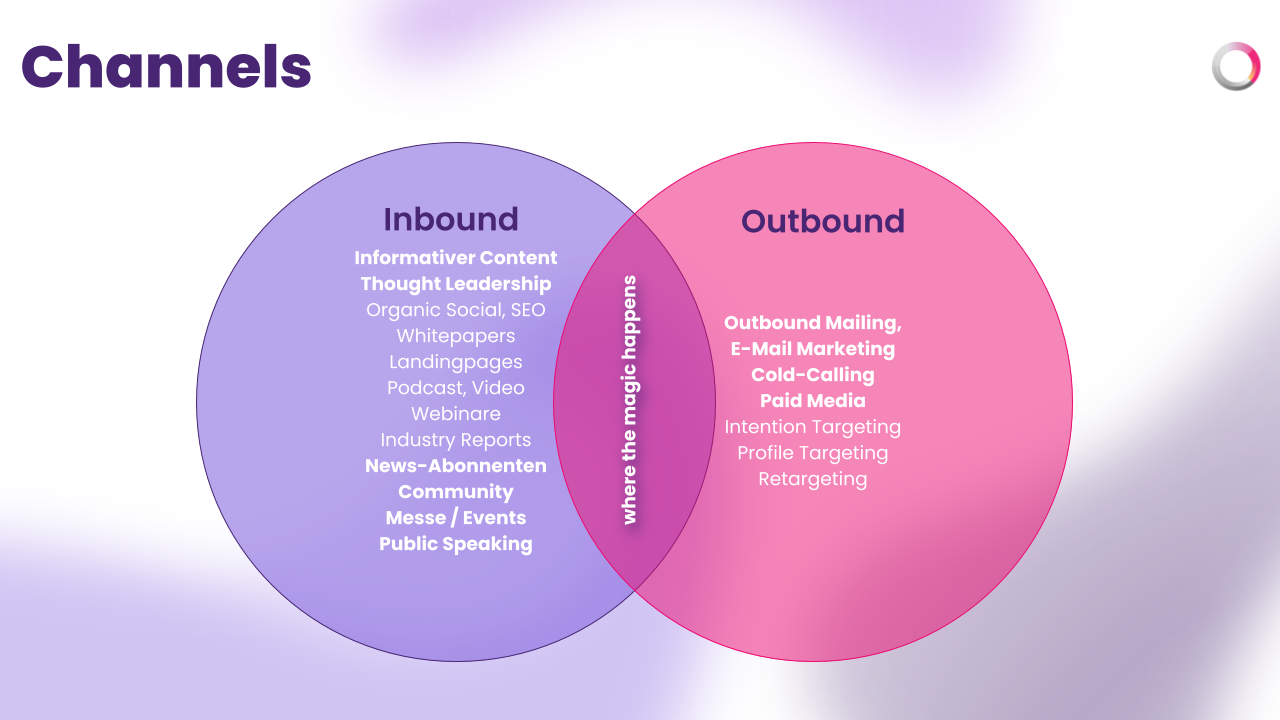
Personal Learnings from the Experts
Personal Learnings as an Entrepreneur: Hacks and Tips, What's Important and What's Not
Question / we're all entrepreneurs: What are your personal experiences as an entrepreneur, what has worked for you as a business in B2B lead generation to identify leads' readiness to buy?
Now for my last question. You are all entrepreneurs, I would like to know what your personal learning is. You have seen there many companies from the inside, but also built your own business. What are the personal tips as your own entrepreneur? What has worked super well for you or for your company for B2B lead generation to identify that purchase readiness as well?
Björn
So I would say two things that have worked well for us in the Finc3 group from my perspective. But this is not an overnight tool. We have built the Finc3 group from three to 180 cash flow colleagues in ten years. But that wasn't in one year either. I think you always need a bit of patience in everything you do. Especially if you want to grow from cash flow and not aggressively burn external capital. But two things that have worked well for us: On the one hand, being useful, so sharing content and knowledge proactively. We do quite a lot of knowledge, knowledge content together with other companies or partners, offer courses, webinars, try to do that not with the goal of generating deals, but simply also to be perceived as someone who knows. Because I think you rarely have this one recipe that always works immediately, but rather you have to be perceived as a company, as a potential contact, if you want to build your own brand and your own visibility. The second thing that is certainly useful is to productize one's own sales process, i.e. to consider at what point do I actually create value in the sales process, so that I don't have to work on larger customers for too long without a budget, without sales. We don't productize workshops because the 1,500 EUR workshop fee triggers me, but because we want to see that companies can make a decision at all. So I don't have to negotiate with a company for a long time about any budget. And I think that applies to almost all B2B companies, if the other party is not able to make a decision at all. And it's always worth considering how I can productize what I'm offering. How can I create value, independent of my concrete offer? For example, if I structure a decision-making process for the customer, what can I demand in return? That gives you a very good qualification opportunity whether you're even talking to the right people and whether they're able or willing to invest 500-1,000 EUR in that decision making.
Kevin, what do you have as a personal super tip?
Kevin
I think even the one super tip does not exist. That is also really very individual. What I can say what has worked for us is content. And that's with the background that we want to help, that we try to gather our knowledge and summarize that, reflect that. Which has then led to people being interested and having similar opinions, attitudes, sometimes wanting to disagree with us, that the leads get in touch with us and we then get into conversation. These are usually interesting conversations and often something results from that. I think that's one angle with producing content and distributing it. What was necessary for us, we were relatively broad at the beginning, then of course also tried to cover too many different things, have then sharpened it again and again and asked ourselves, what can you take away? Not what can we add, but what can we take away? That was always the guiding question for us. And that really helped us get to where we are today.
I think that can help other companies as well. And then certainly the theme of not trying to be fancy and chasing the latest marketing trends, but trying to figure out the things that work. And then “first nail it and then scale it.” So that money isn't thrown out the window. Those are proven things that have worked for us and provided organic growth accordingly.
Cool. Joel, your opinion on, what do you personally have in store as a super trick?
Joël
There are a number of things, of course. With our own story, what really helped and also what we do with every customer that's in our scaling program, first create the data foundation, like Kevin said that. Create end-to-end tracking, the Pirate Funnel model. So I can really see what's going on with the existing channels. Implement lifecycle stages according to industry standards so that I can really understand where the funnel is breaking. And when I have this picture, then I understand what is already working and what is not. Where do I want to invest more time and money? You can then combine that with the aforementioned definition of the go-to-market strategy and understand which channels come into question for me. Then accordingly test those channels as quickly as possible. Focus on two, three channels and then really do them correctly. Better than trying to be everywhere. In the long term, Focus on Value. So, if you just focus on value when working with customers, in sales conversations, in LeadGen itself. We give quite a lot of content, knowledge for free, and I think if you pull that off in the long term like that, value will then come back.
Closing words from the experts
What do you take away from the B2B marketing journey? Do you have a closing word that you would still address to the audience? What do you give them to take away?
Joël
Scaling 101 framework is actually very simple mentioned. So measure, analyze, define the goal, test and then systemize what works. Actually quite simple steps to follow here. Of course, it is much more difficult to implement this in reality. But if you act in such a long-term data-driven way, then I am sure you will become successful.
Kevin
You mentioned the toolbox and the hammer. I think the hammer sometimes you have to take out and just hammer your own views, opinions, impressions and be willing to change your mind. When you see that the data speaks a different language. And by that I don't just mean quantitative data, i.e. analytics, but also qualitative. That is, conversations with real customers, I think that's something that's extremely underrated. Yes, and then I think we really need to create a good basis, first of all get an overview, set clear goals, then use OKRs, for example, to break this down to the individual people working together with a team towards a goal. Perhaps also to do this quarterly in sprints, so that you have fixed milestones, where you can then check where you stand. And then talk. Yes, let up a small balloon at the beginning, see how high it flies and only expand it when you realize that something is possible, you have traction and not scale early on, which does not work. Cool.
Björn
I would say two things. One is, we talked a lot about measurability and analytics. You can just get blatantly bogged down there. So, you always have to keep that in mind. That is, if you get too enamored with it, you start measuring segments that are too small. A good guiding question is “What's the ROI of measuring your ROI?” After that, what decision do I even want to make with this data? Is it worth it for me to make them better? And the second theme from my perspective for growth is, you can set a goal and hard from that what you need to do. Often in companies there are quite diffuse goals: we want to grow and more visibility and brand and so on. But it does help to force yourself to take a speedometer needle that you want to move and then really derive from that, what are my initiatives, whatever toolkit you're doing it with, OKRs, backlog and so on. But I would always take a needle, a KPI, a metric, just work on that, at least for a quarter. That's more like this scaling up method, that you work with these rocks that you then try to get out of the way, I always found more useful in our personal history than having too complex frameworks.
Comments